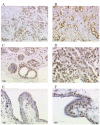Correlation of thyroid hormone, retinoid X, peroxisome proliferator-activated, vitamin D and oestrogen/progesterone receptors in breast carcinoma
- PMID: 23205080
- PMCID: PMC3506670
- DOI: 10.3892/ol.2012.799
Correlation of thyroid hormone, retinoid X, peroxisome proliferator-activated, vitamin D and oestrogen/progesterone receptors in breast carcinoma
Abstract
Non-steroidal nuclear receptors play a major role in breast cancer development. A correlation among, and possible prognostic function of, the members of the nuclear receptor superfamily has been discussed controversially over the years. Hence, we conducted a quantification of the different expression levels of the thyroid receptor (TR), retinoid X receptor (RXR), peroxisome proliferator-activated receptor (PPAR) and vitamin D receptor (VDR) in malignant breast tumour tissue samples. Patients diagnosed and treated for breast cancer between 1990 and 2000 were included. Receptor expression was detected by immunohistochemical staining. Correlation analyses for the expression of the receptors were performed for the clinical and histopathological data. The paraffin-embedded tissue from 82 breast cancer patients was available. The different steroid receptors showed varying results when correlated with known histopathological markers. TRα2 demonstrated the most significant correlations with steroid hormone receptors. Significant correlations between the major isoforms of TR, and between RXR, PPAR and VDR, were demonstrated in the patient sample. The immunohistochemical association of these receptors may provide the first proof of an interaction on the molecular level. This assumption awaits confirmation in studies with larger cohorts.
Figures


References
LinkOut - more resources
Full Text Sources
